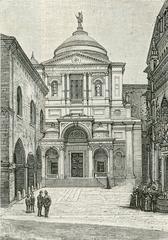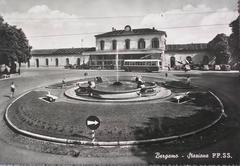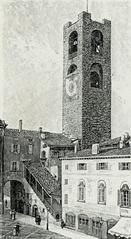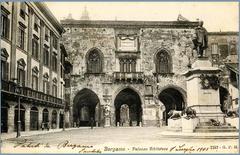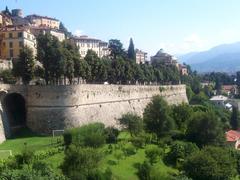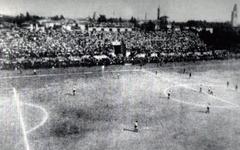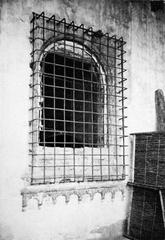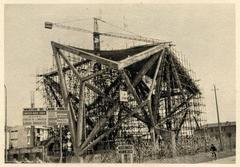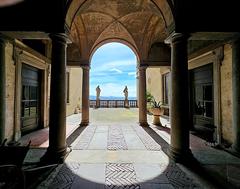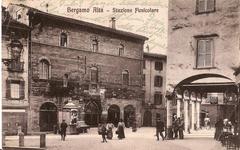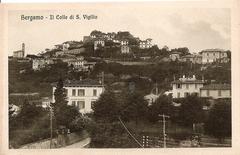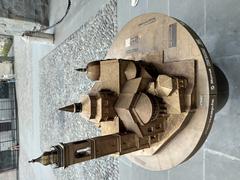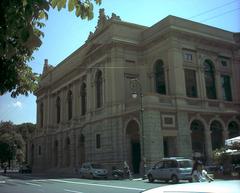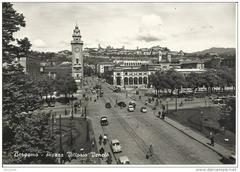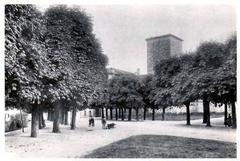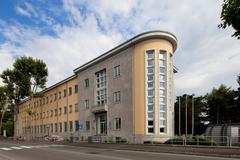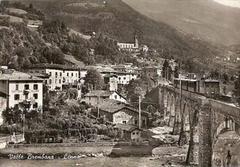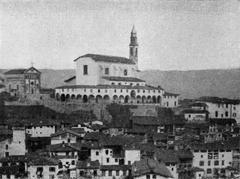Baptistry of Bergamo: Visiting Hours, Tickets, and Historical Significance
Date: 14/06/2025
Introduction
Situated in the heart of Bergamo’s historic Città Alta, the Baptistry of Bergamo stands as a compelling emblem of medieval religious architecture, artistic achievement, and enduring spiritual tradition. Commissioned in 1340 by the renowned sculptor Giovanni da Campione, this octagonal monument is a striking example of Lombardy’s rich cultural and theological heritage during a flourishing era of urban and ecclesiastical development. Its detached structure, characteristic of Italian ecclesiastical design, emphasizes the profound significance of baptism as a rite of spiritual rebirth and community initiation in medieval Christianity (Baptistry of Bergamo: Visiting Hours, Tickets, and Historical Guide; Architecture of Cities).
The baptistry’s blend of Gothic and Romanesque elements, evident in its intricate bas-reliefs and statues personifying Christian virtues, offers visitors an artistic and educational experience. The building’s history of relocation and 19th-century neo-Gothic restoration reflects Bergamo’s ongoing dedication to preserving its historical and artistic legacy (Nomads Travel Guide; Lonely Planet).
Today, the Baptistry of Bergamo welcomes visitors with accessible hours, affordable ticket options, and a range of guided and self-guided tours. As part of a cluster of historic landmarks—including Bergamo Cathedral and the Basilica of Santa Maria Maggiore—it remains a cornerstone of the city’s spiritual and civic identity, inviting reflection on centuries of faith and artistry (Visit Bergamo; Bergamo by Tuk Tuk).
Historical Overview
Origins and Early History
The Baptistry of Bergamo was established in 1340 by Giovanni da Campione as a separate structure adjoining the Basilica of Santa Maria Maggiore, in line with the Italian tradition that only the baptized could enter the main church (Wikipedia: Bergamo Cathedral; Architecture of Cities). This period marked significant urban and religious growth in Bergamo, whose medieval core was shaped by both Celtic and Roman influences and later flourished as a center of art, commerce, and faith (Bergamo by Tuk Tuk).
Architectural Evolution
Original Design and Features
The baptistry’s octagonal plan, symbolizing regeneration and eternity, reflects common themes in Italian ecclesiastical design. Giovanni da Campione’s blend of Gothic and Romanesque styles is evident in the robust stonework, arches, and an upper colonnade. Eight statues representing the Virtues adorn the exterior. Inside, visitors find expressive bas-reliefs from the Life of Christ, a statue of John the Baptist, and the original baptismal font—all crafted by da Campione and his workshop (Wikipedia: Bergamo Cathedral).
Relocation and Restoration
The baptistry was dismantled in 1650 during renovations of the Basilica and reassembled in 1856 in the canons’ courtyard. Its final relocation in 1889, overseen by Virginio Muzio, placed it next to the Bergamo Cathedral, with neo-Gothic enhancements harmonizing it with the historic urban context (Bergamo by Tuk Tuk).
Cultural and Religious Significance
The Sacrament of Baptism
The baptistry served as the site for the sacrament of baptism, a foundational Christian rite symbolizing rebirth and communal belonging. Its octagonal layout and moral iconography highlight the transformative significance of baptism (Architecture of Cities).
Artistic Heritage
The baptistry is home to Lombard Gothic masterpieces, particularly the bas-reliefs and statues by Giovanni da Campione. These artworks provided biblical instruction to the largely illiterate medieval public and have been carefully preserved through successive restorations, reflecting Bergamo’s commitment to its artistic legacy (Bergamo by Tuk Tuk).
Architectural Features
Octagonal Plan and Symbolism
The structure’s octagonal shape represents regeneration and eternal life, connecting it to the theological concept of the “eighth day” and aligning it with other Italian baptistries such as those in Florence and Parma (myCityHunt).
Materials and Construction
Constructed primarily of red Verona and Musso marble, the baptistry’s materials reflect both regional resources and the broader Lombard tradition. The interplay of light on the marble enhances its visual appeal (myCityHunt).
Restoration and Neo-Gothic Elements
During its 19th-century relocation, architect Virginio Muzio incorporated neo-Gothic features such as decorative pinnacles and a lantern topped by an angel, further integrating the baptistry into the historic square (Nomads Travel Guide).
Artistic Highlights
Exterior Sculptures
A series of eight statues representing the Christian virtues—Faith, Hope, Charity, Fortitude, Justice, Prudence, Temperance, and Patience—adorn the cornice of the dome, serving as a moral guide for visitors (Lonely Planet).
The Portal
The main portal, attributed to Giovanni da Campione, features Gothic carvings with vegetal and biblical motifs, marking the transition from the secular to the sacred (myCityHunt).
Lantern and Angel
A crowning lantern and angel symbolize divine guidance and complete the building’s vertical ascent (myCityHunt).
Interior Artwork
Inside, the cycle of bas-reliefs by Giovanni da Campione illustrates episodes from the life of Christ, providing both narrative and spiritual education (Nomads Travel Guide). The marble floor, with its two-toned design, symbolizes the waters of the Jordan and leads the eye to the central baptismal font. In each corner, statues representing the sacraments further connect the space to its liturgical function (myCityHunt).
The Baptistry in Urban and Spiritual Context
The baptistry stands in Piazza del Duomo, surrounded by other religious monuments. Together, these buildings form a cohesive ensemble that narrates the city’s religious and artistic achievements (Lonely Planet).
Visiting the Baptistry of Bergamo: Practical Information
Location and Access
The Baptistry of Bergamo is located in Piazza del Duomo in Città Alta, opposite the Cathedral of Sant’Alessandro. The area is pedestrian-friendly, and the nearest public transport stop is Piazza Mercato delle Scarpe, accessible by bus Line 3 and the funicular from the Lower Town.
Visiting Hours and Tickets
- Hours: As of June 2025, typically open Wednesday to Sunday, 10:00 am–6:00 pm (last entry 5:00 pm). Hours can vary—confirm via the official Visit Bergamo website.
- Tickets: Full-price entry is around €11; reduced rates for students and children. Children under 5 and FAI members enter free. Tickets can be purchased onsite or online (Visit Bergamo).
Best Times to Visit
Visit early morning or late afternoon for a quieter experience, especially in spring or autumn to avoid peak crowds.
Accessibility
The baptistry is in a pedestrian area with cobblestone streets. While there are no major steps, full wheelchair accessibility is limited. Contact the tourist office for assistance.
Visitor Services
- Restrooms: Available nearby in Piazza Duomo.
- Guided Tours: Book via the official tourism website for a deeper understanding.
- Information Panels: Multilingual panels and audio guides are available.
- Luggage Storage: Facilities are located near the funicular and main transport hubs.
Dress Code and Etiquette
Modest attire covering shoulders and knees is required. Silence and respect for ongoing religious ceremonies are expected. Do not touch artworks or the font, and wait for rituals to conclude before moving through the space (jamtraveltips.com).
Photography
Photography is generally allowed without flash or tripods. Restrictions may apply during services or special events—always check signage or ask staff.
Nearby Attractions
Explore the adjacent Cathedral of Sant’Alessandro, Basilica di Santa Maria Maggiore, and Colleoni Chapel for a comprehensive view of Bergamo’s religious and artistic heritage (ibnbattutatravel.com; PlanetWare).
Practical Tips
- Language: Staff generally speak Italian and some English.
- Safety: Bergamo is safe and clean, but watch belongings in crowded areas.
- Weather: Dress for the season; approach to the baptistry is outdoors.
- Food: Enjoy local specialties in Città Alta, such as “polenta e osei” cake.
- Booking: Group tours require advance booking; individual visits usually do not.
- Payment: Credit cards accepted; bring small euro notes for minor services.
- Tipping: Not required but appreciated for excellent service.
Health, Safety, and Sustainability
No special vaccinations are required. Emergency medical services are available. Help preserve the site by following rules, minimizing noise, and supporting local businesses.
Frequently Asked Questions (FAQ)
What are the Baptistry of Bergamo opening hours?
Typically Wednesday to Sunday, 10:00 am to 6:00 pm, with last entry at 5:00 pm. Confirm via the official website.
How much do tickets cost?
Full-price tickets are around €11, with reductions for students and children; free for children under 5 and FAI members.
Is the Baptistry wheelchair accessible?
There is limited accessibility due to the historic setting. Contact the tourist office for assistance.
Can I take photos inside?
Yes, photography is generally allowed without flash or tripods. Check for restrictions during ceremonies.
Are guided tours available?
Yes, guided tours are recommended and can be booked through the tourism office or online.
The Baptistry’s Enduring Legacy
The Baptistry of Bergamo is more than a historic monument; it is a living symbol of the city’s faith, artistry, and community. Its continued use for sacraments and its role in public celebrations ensure that it is an active participant in Bergamo’s spiritual and cultural life. The preservation of its architecture and works by Giovanni da Campione underscore its status as an invaluable artistic and spiritual landmark (Best of Bergamo).
Plan Your Visit and Stay Connected
For the latest information on visiting hours, tickets, and accessibility, consult the official Visit Bergamo website. Download the Audiala app for immersive self-guided audio tours and further resources on Bergamo’s historical sites.
Sources
- Baptistry of Bergamo: Visiting Hours, Tickets, and Historical Guide to Bergamo’s Iconic Monument
- Architecture of Cities: Italian Baptistries
- Bergamo by Tuk Tuk: Bergamo’s History and Heritage
- Baptistry of Bergamo: Visiting Hours, Tickets, and Artistic Highlights
- Nomads Travel Guide: Battistero di Bergamo
- Lonely Planet: Baptistry of Bergamo
- Best of Bergamo: Bergamo’s Baptistery
- Visit Bergamo: Official Baptistry Information
- ibnbattutatravel.com: Unlock Bergamo, Italy’s Best-Kept Secrets
- PlanetWare: Bergamo Attractions
- jamtraveltips.com: Churches in Italy – What to Wear and Other Rules
